The Big Difference Between Vaping Dry Herb Vs E-liquids
Vaping dry herb isn't the same as inhaling e-liquids. High-quality cannabis flower is free from additives, harmful chemicals, and other contaminants. Overall, it's very different from e-liquids. Read on to find out why.
Vaping has been dominating the headlines after hundreds of people have fallen victim to a mysterious lung disease. An exact ingredient behind the illnesses hasn't been identified, but officials have issued a statement urging people to stop vaping. However, dry herb vaping hasn't been involved in any of these instances. All of the people affected were inhaling e-liquids.
THE ISSUE WITH E-LIQUIDS
E-liquids are notoriously under-labelled, and many aren't FDA-approved. This increases the risk of contaminated products and subsequent illnesses. Plus, it's impossible to assess their contents without lab analysis. Dry herb, in contrast, is a more transparent option. High-quality flowers are easier to identify, are a higher standard is generally held in dry herb production.
Several countries and major cities are moving to ban the sale of e-liquids due to the recent health scare. The Centers for Disease Control (CDC) is investigating the cause of the illnesses. Those affected have experienced symptoms including shortness of breath, fatigue, chest pain, and vomiting.
Aside from these tragic cases, e-liquids are proving to be unhealthy in the long-term too. Once thought to be a healthier alternative to smoking, e-liquids are now under scrutiny. World Health Organisation data (WHO Global Report on Trends in Prevalence of Tobacco Use 2000-2025, Fourth Edition, 2021) shows that as the global smoking population decreases, the number of vapers is on the rise. Seven million vapers in 2011 turned into 41 million by 2018.
This surge in popularity was, in part, catalysed by research that found e-cigarettes to be healthier than smoking. As opposed to the smoke of a cigarette, e-liquids turn into vapor via devices such as vape pens. This aerosol is void of the many carcinogens and toxic chemicals found in cigarette smoke, but is still by no means “clean”.
E-liquid vapor has been found to contain substances that are addictive and can cause heart disease and certain types of cancer. But e-liquids aren’t the only way to vape. Vaporizing is extremely popular among both nicotine and cannabis users. While tobacco is rarely—if ever—vaped in its raw form, cannabis commonly is.
There is a significant difference between vaping cannabis e-liquid, concentrates, and raw flowers. Let’s explore the differences between these vaping products, and see why some of the dangers of e-liquids don’t apply to flower and concentrates.
WHAT IS THE DIFFERENCE BETWEEN DRY HERB VAPING AND E-LIQUID VAPING?
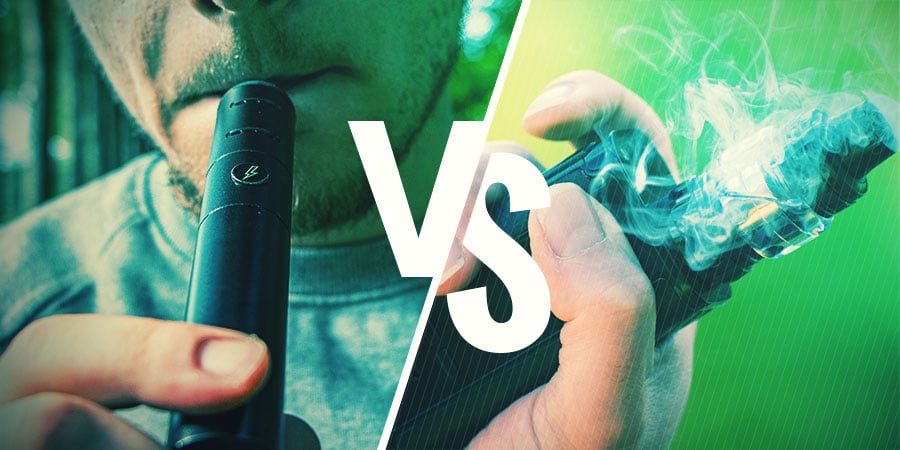
E-liquids are consumed using specialised e-liquid vapes. These devices heat liquid and convert it into vapor. Unlike smoked products, this process doesn’t involve any combustion. The benefit here is that they don’t generate any tar or carbon monoxide—harmful byproducts of smoking.
E-liquids vary in their ingredients. They are commonly made using a base of propylene glycol (PG) and/or vegetable glycerine (VG). Manufacturers then add an assortment of ingredients such as terpenes, cannabinoids, and nicotine to the preparation.
Dry herb vaping refers to vaporizing the unprocessed flowers of the cannabis plant. Buds are typically ground up before being added to the chambers of desktop or portable devices.
Vaporshop
Shop for the best portable and desktop vaporizers from the world's top manufacturers here!
Depending on the device, the herb can be vaporized at a specific temperature to target particular cannabinoids and terpenes in the plant material. Dry herb vapes use different mechanisms to heat flowers. Convection models circulate hot air through the plant matter, whereas conduction devices place a heating element in direct contact with the herb.
Dry herb vaping also largely avoids combustion, and is therefore mostly free of tar, carbon monoxide, and other harmful smoking by-products.
THE DANGERS OF E-LIQUID VAPING DON’T APPLY TO DRY HERB

Dry herb vaping is relatively pure in comparison to e-liquid vaping. Provided your flower hasn’t been subject to pesticides, you’ll receive a cleaner hit of cannabinoids.
In comparison, the ingredients in e-liquids aren’t so clear-cut. Although the base is usually the same, manufacturers load them up with flavouring chemicals and other additives. Expensive laboratory testing is the only way to discover all the ingredients. This means e-liquid vapers have to trust the integrity of manufacturers.
E-liquid products rarely give in-depth information regarding ingredients, and many of them display no quality marks. Even if a product is certified and tested, doubts remain as to the validity of these claims.
Some e-liquids are made using a base of propylene glycol, a lab-made chemical known to irritate the lungs. Others feature vegetable glycerine as a base. The FDA has announced both substances to be safe as food additives, but how safe they are for inhalation isn’t known.
Although e-liquid vapes don’t use combustion, toxic chemicals are still released when e-liquids are heated. One such compound is formaldehyde, a cancer-causing chemical used in building materials. Another is acrolein, a substance that damages the lungs and contributes to heart disease.
Various chemicals are added to the base to flavour and enhance e-liquids, such as cannabinoids (CBD and THC), terpenes, nicotine, and flavouring chemicals. Hundreds of flavouring chemicals are added to products to generate specific flavours, but the safety surrounding these additives is up in the air.
When mixed with the bases mentioned above, some flavouring chemicals react and form substances known to be harmful to the lungs.
WHAT ARE THE OTHER TYPES OF VAPES?
Dry herb vapes aren't the only way to avoid the risks associated with e-liquids. Different devices can be used to vape cannabis concentrates, waxes, and oils.
WAX/CONCENTRATE VAPES
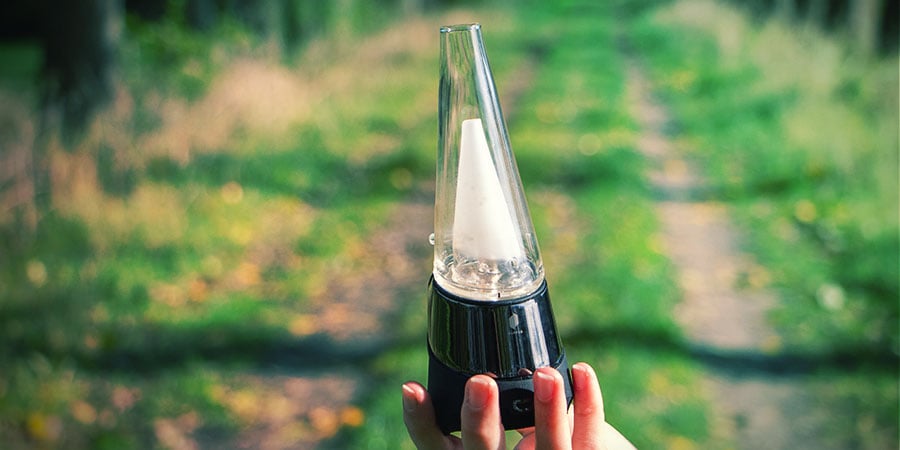
Cannabis concentrates are extracts that contain high levels of cannabinoids. They arrive in the form of wax, crumble, budder, shatter, oil, and more. This variation in texture has less to do with how the substance was extracted, and more to do with how it was processed post-extraction. Due to their high concentration of cannabinoids, these extracts provide much more pronounced effects.
Extracts are highly purified and don’t contain the chlorophyll and other harsh substances found in dried flower. Specialised desktop and portable models are used to vaporize concentrates, which feature suitable hardware like tailored heating chambers.
The Peak by Puffco is an excellent example of a concentrate vaporizer. Accurate temperature settings allow users to target specific cannabinoids and terpenes, and the impressive battery life offers 30 dabs per charge.
OIL VAPORIZERS/VAPE CARTS
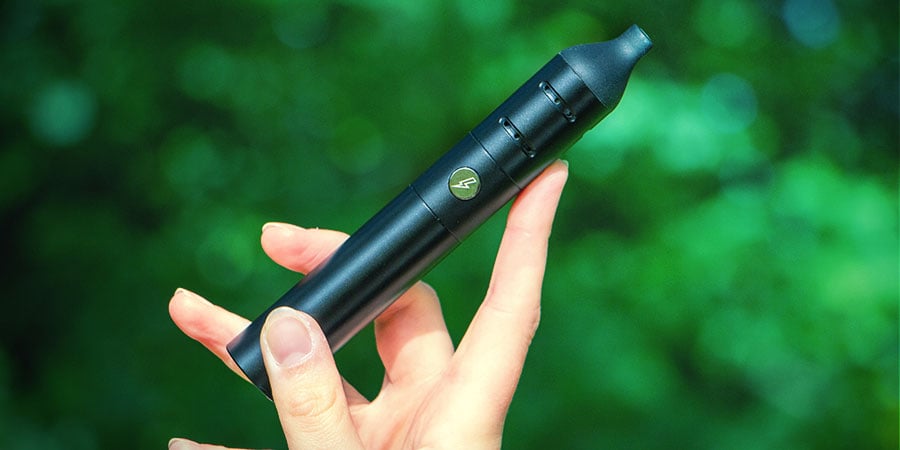
Cannabis oil is another type of concentrate. Oil vapes or “vape carts” work similarly to the other cannabis vapes discussed. However, they are specialised in processing high-potency, vicious extracts. These vapes are usually quite simple in comparison to others, featuring only a heating coil, a disposable chamber to hold the oil, a mouthpiece, and an atomizer. Cannabis oils aren’t as easy to examine for purity as dry herb and some other extracts, and they sometimes contain additional ingredients. It’s important to source oil vapes from reputable outlets to ensure the product is clean. That being said, cannabis oils are NOT e-liquids! It’s important to not confuse the two.
The Storm Vaporizer is compatible with cannabis oils. The sleek and portable pen features a ceramic heating chamber that gently heats oils, preserving their rich flavours.
HYBRID VAPORIZERS
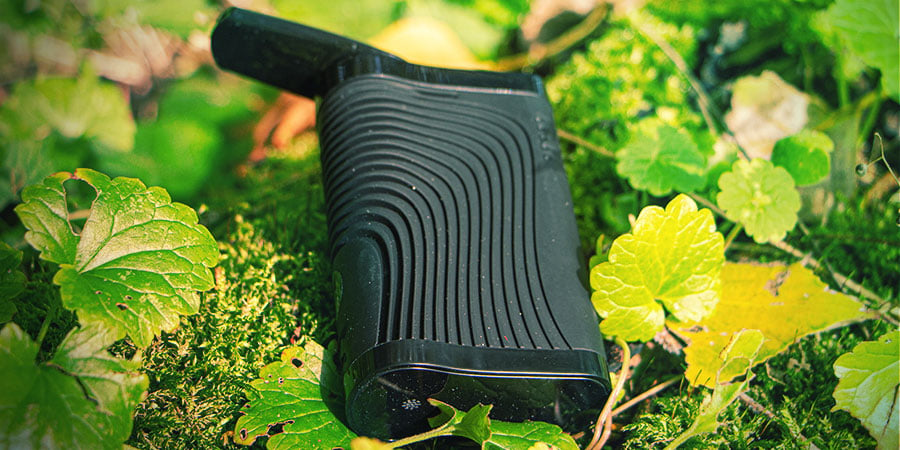
Hybrid vapes are for those who enjoy fluctuating between extracts and dried flower. These devices are designed to handle both types of cannabis with ease. Most are highly portable and remove the need to buy two models to vape different products.
The Crafty+ by Storz & Bickel is a portable hybrid vape, no bigger than a smartphone, and is compatible with both herbs and concentrates. Can't decide what you want to vape today? Pack the Crafty+ and make up your mind later.
- WHO. (2021, November 16). WHO global report on trends in prevalence of tobacco use 2000-2025, fourth edition. - https://www.who.int
-
 5 min
October 4, 2021
How To Clean Your Vaporizer
Cleaning your vaporizer regularly allows the device to perform just like it did on the first day you bought it. Find out why and how to clean various types of vaporizers, including dry herb vapes,...
5 min
October 4, 2021
How To Clean Your Vaporizer
Cleaning your vaporizer regularly allows the device to perform just like it did on the first day you bought it. Find out why and how to clean various types of vaporizers, including dry herb vapes,...
-
 5 min
March 23, 2020
Best Legal Herbs to Vaporize
All of the following herbs are legal and can be vaped to your heart’s content! Many of them have long been used by herbal practitioners. Enjoy them alone or mix them in with your cannabis!
5 min
March 23, 2020
Best Legal Herbs to Vaporize
All of the following herbs are legal and can be vaped to your heart’s content! Many of them have long been used by herbal practitioners. Enjoy them alone or mix them in with your cannabis!
-
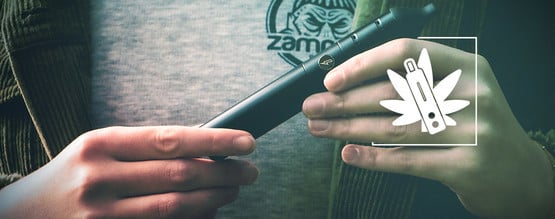 3 min
December 18, 2019
How Do Weed Vaporizers Work?
For many, vaporizing has become the ultimate way to get high. It‘s healthier, smoother and saves money. But what‘s actually going on in these little devices? How is the vapour produced?
3 min
December 18, 2019
How Do Weed Vaporizers Work?
For many, vaporizing has become the ultimate way to get high. It‘s healthier, smoother and saves money. But what‘s actually going on in these little devices? How is the vapour produced?
-
 3 min
March 27, 2019
The Advantages of Vaping: Why It's The Smarter Choice
It may not come as a surprise: vaporizers are slowly becoming the ingestion method of choice—even overtaking the joint. Vaporizers are on the rise, and there are many good reasons behind it.
3 min
March 27, 2019
The Advantages of Vaping: Why It's The Smarter Choice
It may not come as a surprise: vaporizers are slowly becoming the ingestion method of choice—even overtaking the joint. Vaporizers are on the rise, and there are many good reasons behind it.











 United States
United States










